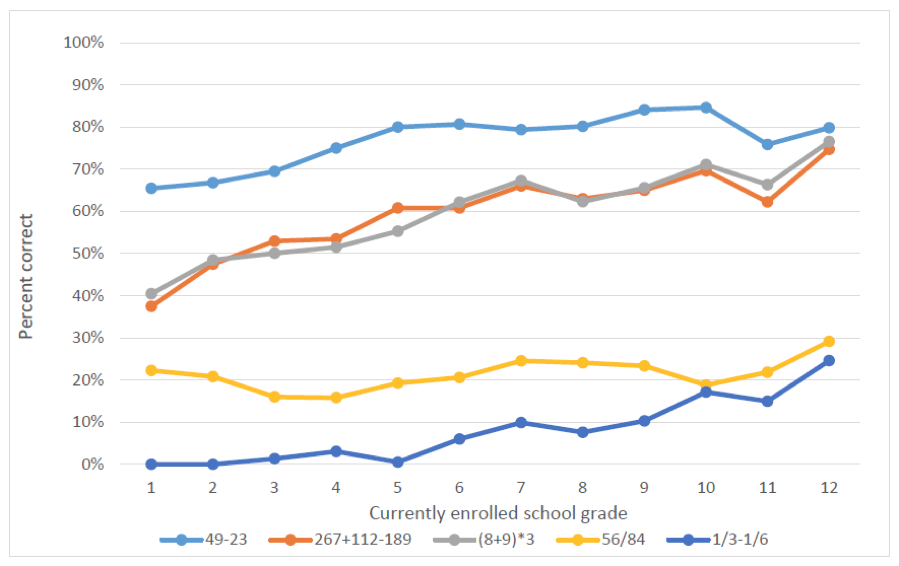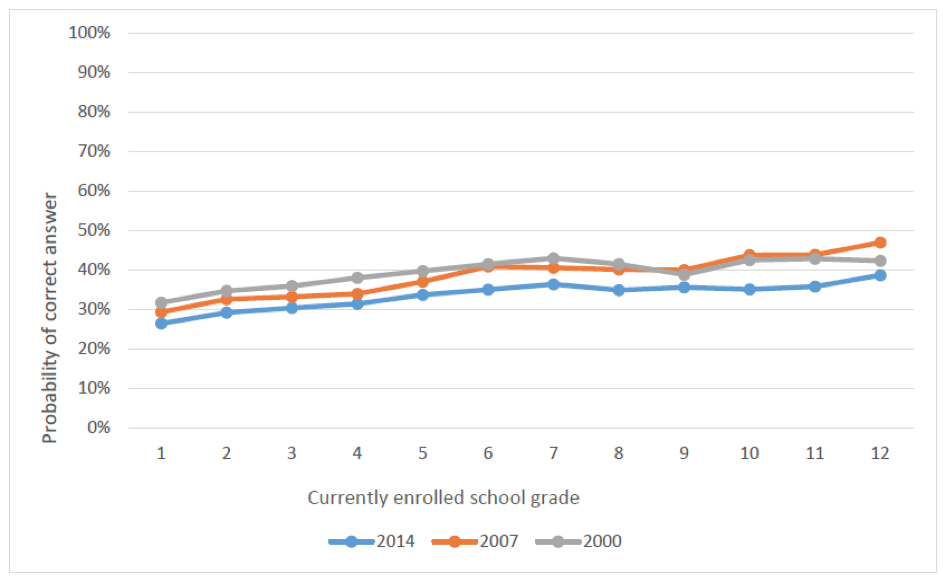Maryam Akmal
Center for Global Development
Blog
Imagine an economically thriving and democratic middle-income country that has achieved near universal primary school enrollment, tripled percentage of total government expenditure on education since 2000 (in real terms), and roughly doubled teacher salaries. You would think all is well, right? But new measures of learning progress show low absolute and marginal learning as students are promoted from grade to grade. You would, and should, be shocked. Unfortunately, you don’t need to imagine. This is the story of Indonesia—the fourth largest education system in the world.
At the recent RISE Annual Conference, a presentation by Emilie Berkhout and co-authors examined 15 years of flat learning profiles in Indonesia. The authors use multiple choice questions about simple arithmetic operations posed to all respondents in the Indonesian Family Life Survey (IFLS), a nationally representative panel dataset covering 2000 to 2014, to estimate the descriptive grade learning profile—the fraction of people at each grade level who are able to answer correctly. Reducing a fraction (e.g., knowing that 56/84 is the same number as 2/3) is meant to be mastered at the Grade 4 level, yet almost 20 percent in Grade 1 got the answer right compared to only 30 percent in Grade 12. Somehow, in 12 years of schooling, only 1 in 10 students learned to reduce fractions. The multiplication task (8 + 9) x 3 is simple if one understands either order of operation (first add 9 + 8 to get 17 and then multiply by 3 to get 51) or the distributive law that (3 x 8) + (3 x 9) = 51. This is simple and half of children in Grade 3 can do that correctly. However, by Grade 10, only 70 percent of children can perform this simple multiplication task. So, of the half of children who didn’t understand these simple rules of arithmetic by Grade 3, only 2 of 5 (an additional 20 percent of the total) came to understand them in seven more years of schooling. And for even the simplest question involving fractions, 1/3- 1/6, less than 20 percent of children in Grade 10 can answer correctly.
How is it possible that children are able to persist through to Grade 10 and even into Grade 12 without conceptual mastery over the simplest possible elements of arithmetic operations (and these don’t even probe whether students can understand and apply these basic numeracy skills)?
Indonesian children are supposed to spend around 240 days per year in school. If they spend an hour a day on math, that means children are intended to spend 240 hours per year learning math, or 2400 hours from Grade 1 to Grade 10. This is roughly equivalent to an entire year of a full-time 40-hours-per-week job. So here we have kids spending a total of 2400 hours on math from Grade 1 to Grade 10, yet 3 in 10 cannot answer (8 + 9) x 3 and only 1 in 5 can answer 1/3- 1/6.
Figure 1: There is shockingly little progress on answering multiple choice questions about simple arithmetic operations as students move through schooling

Note: Percent who answered each question correctly, by grade level in 2014, adjusted for guessing.
What is, in some ways, even more shocking than how shallow the learning profile is, is that the mastery of numeracy skills deteriorated at each grade between 2000 and 2014. Children in Grade 10 were less likely to answer a typical question correctly in 2014 than in 2000.
Figure 2: Numeracy skills of children at each grade level deteriorated between 2000 and 2014

Note: Mean probability of answering a question correctly, by grade level, adjusted for guessing.
Shallow learning profiles are not a uniquely Indonesian problem. Data from household based learning assessments from South Asia and Africa paints a similar picture. And sources suggest that in India, the largest schooling system in the world, learning has deteriorated. And, by the way, these are descriptive learning profiles of enrolled children which almost certainly overstate learning as more adept children are more likely to move ahead in grades.
Two over-arching questions for RISE are: How can learning profiles be this awful? And why is progress so slow (even negative) in improving learning profiles?
After the opening paper on Indonesia’s shallow learning profiles that set the scene for the RISE conference, a second paper emphasized how important these learning gains are for producing the improvements in human well-being we expect from schooling. Achieving literacy accounts for a significant percentage of the improvement in child mortality, fertility, and female empowerment. Learning produces more of the human well-being gains we hope to get from schooling, and the non-pecuniary benefits from female education are even higher than previously thought.
A third paper presented facts about bracing the challenge that many countries face in improving learning: teachers often lack knowledge of even the basics they are expected to teach. According to a recent paper by Bold et al. (2017) based on the Service Delivery Indicators (SDI) data, teacher subject knowledge is an important determinant of student learning. However, many teachers in sub-Saharan Africa struggle with tasks that their students should master in lower primary school. If these students were taught by teachers who actually had mastery over lower secondary curriculum, students would acquire an additional three-quarters of a curriculum-scaled year of schooling after four years. But the average effective mastery of mathematics of a typical teacher in select African countries is only equivalent to 3.7 years of quality adjusted education. That is to say, these countries are trying to teach students mathematics with teachers who barely grasp the basics themselves.
Figure 3: The typical primary school teacher in seven Sub-Saharan Africa only masters the math curriculum at between a third and fourth grade level

Source: Own visualization based on data from Bold et al. (2017)/Service Delivery Indicators
At the end of the day, countries have to go to war on illiteracy and innumeracy with the army they have. That means we have to be cognizant of the existing capacity constraints. It also means that we may not be able to simply import policy solutions from Finland or other high-performing countries operating in different contexts and under different constraints.
According to an estimate by UNESCO, countries must recruit 68.8 million teachers by 2030. At the same time, the bulk of the teaching workforce has already been recruited and a significant proportion will likely retain their public sector jobs for the rest of their working lives. While new hiring offers an opportunity to break the cycle of poor teaching by using the right incentives to attract, retain, and motivate teachers who can teach well, the existing teaching workforce will also need to be equipped to better teach students through incentives that retain and motivate those that can perform well and by giving them the right supporting resources and tools. At the same time, school systems need to be able to measure the learning progress of children early in the school cycle, instead of relying on high stakes examinations administered much later. This can enable education systems to figure out what students do and do not understand early on and allow teachers the chance to adjust the curricular pace without the pressure of expectations to excel at high-stakes examinations.
Fifteen years from now, a new generation of children will have completed schooling. Will they be lost to the learning crisis like many of their predecessors or will they emerge equipped with the skills needed to become productive members of the society? Let’s not wait another fifteen years to find out.
RISE blog posts and podcasts reflect the views of the authors and do not necessarily represent the views of the organisation or our funders.